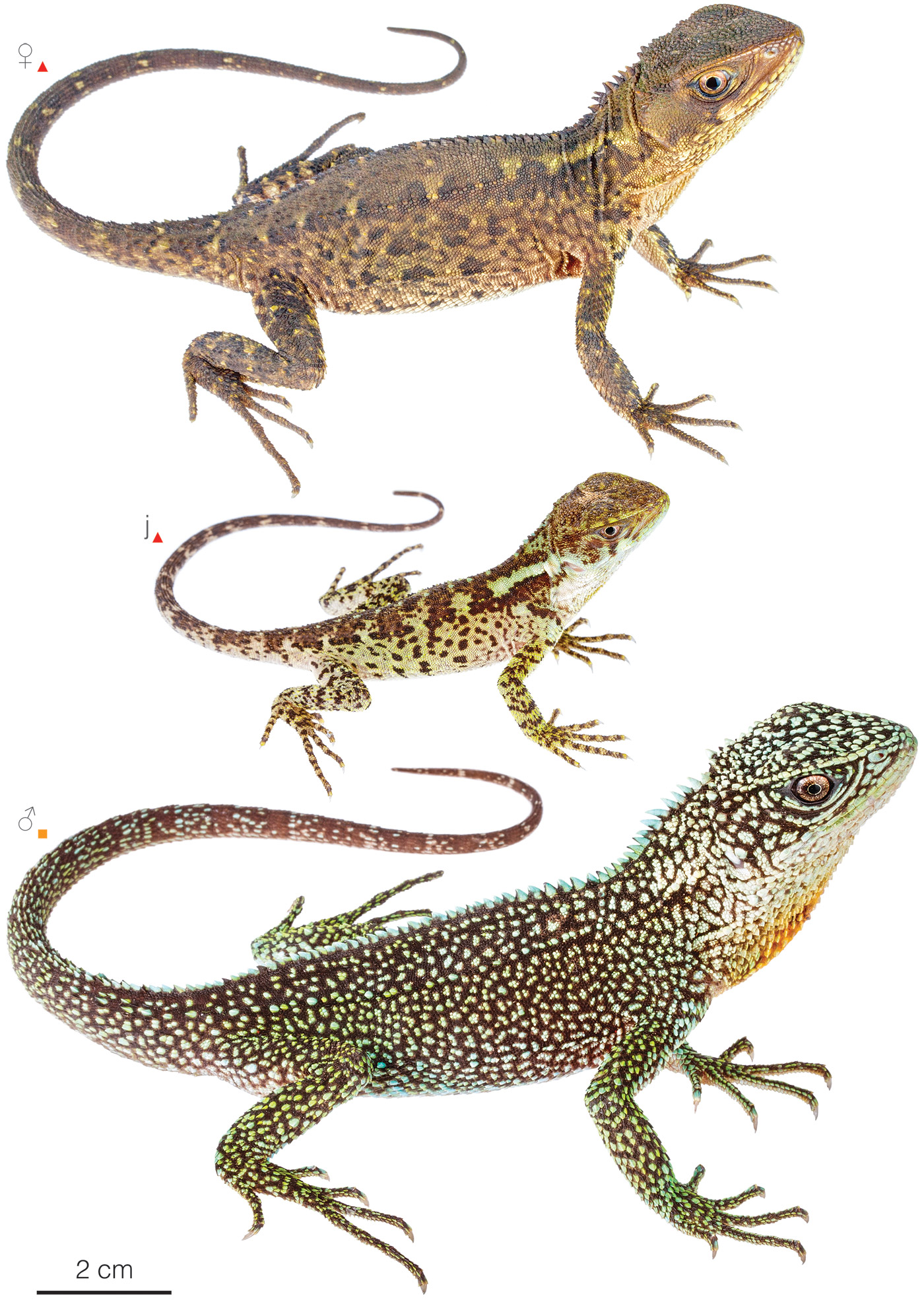Published July 16, 2018. Updated December 2, 2023. Open access. | Purchase book ❯ |
Rough-scaled Dwarf-Iguana (Enyalioides anisolepis)
Reptiles of Ecuador | Sauria | Hoplocercidae | Enyalioides anisolepis
English common names: Rough-scaled Dwarf-Iguana, Rough-scaled Woodlizard.
Spanish common names: Iguana enana rugosa, lagartija de palo de escamas ásperas.
Recognition: ♂♂ 34.2 cmMaximum distance from the snout to the tip of the tail. Snout–vent length=13.0 cm. ♀♀ 31.3 cmMaximum distance from the snout to the tip of the tail. Snout–vent length=11.9 cm..1 Enyalioides anisolepis can be distinguished from other lizards in its area of distribution by having a light bluish green to brownish coloration, dorsal surfaces granular with scattered conical scales, a strongly projected spiny vertebral crest (Fig. 1), and a skull roof (casque head flattened at the top).1 The most similar species is E. praestabilis, but the dorsal scales in this other woodlizard are homogeneously low rather than heterogeneous.1,2 Another congener, E. laticeps, also occurs in the Río Mayo basin, but this species can be recognized by its longitudinal pale stripe running from the corner of the mouth to the tympanum.2

Figure 1: Individuals of Enyalioides anisolepis from El Chorro () and Río Isimanchi (), Zamora Chinchipe province, Ecuador. j=juvenile.
Natural history: Enyalioides anisolepis is a terrestrial to semi-arboreal lizard that is difficult to observe due to its intricate camouflage.3 This species inhabits both pristine and heavily disturbed foothill rainforests, as well as forest remnants within a matrix of pastures, occurring in greater densities near streams and rivers.3 Rough-scaled Dwarf-Iguanas are typically active at ground level during the daytime, with a tendency to roost at night on stems and tree trunks 0.2–1.5 m above the ground.3 They often sleep in proximity to their dens, which are holes in the ground where they retreat if disturbed.3 Individuals of E. anisolepis employ various strategies to avoid predators, such as remaining motionless and blending seamlessly with the vegetation or swiftly moving into the cover of surrounding plants. When captured, males of this species undergo a remarkable coloration change, transitioning from bright green to dark brown.3
Conservation: Vulnerable Considered to be facing a high risk of extinction in the mid-term future.. Enyalioides anisolepis is listed in this category due to its extent of occurrence, which is smaller than 5,000 km2, and its habitat, which is severely fragmented and experiencing a continuous decline in both extent and quality. The valley of the Río Mayo faces numerous intricate threats, including logging, agricultural expansion, mining, and hydroelectric projects.4
Distribution: Enyalioides anisolepis is native to the valley of the Río Mayo in extreme southern Ecuador and northern Perú (Fig. 2).

Figure 2: Distribution of Enyalioides anisolepis in Ecuador. The star corresponds to the type locality: Río Mayo, Zamora Chinchipe province. See Appendix 1 for a complete list of the presence localities included in the map.
Etymology: The generic name Enyalioides, which comes from the Latin words Enyalius (a genus of neotropical lizards) and the suffix oides (=similar to), refers to the similarity between lizards of the two genera. The specific epithet anisolepis is derived from the Greek words anisos (=unequal) and lepis (=scale), and refers to the heterogeneous dorsal scales.1
See it in the wild: Rough-scaled Dwarf-Iguanas are usually found in closed-canopy situations rather than in open or semi-open areas. These perfectly camouflaged reptiles are easier to detect by sampling riparian vegetation at night with the aid of a flashlight. In this way, roosting individuals may be detected at a rate of at least once per night, particularly in gallery forests along the Río Mayo.
Author and photographer: Alejandro ArteagaaAffiliation: Fundación Khamai, Reserva Arlequín, Ecoruta Paseo del Quinde km 56, Santa Rosa de Mindo, Pichincha 171202, Ecuador.
How to cite? Arteaga A (2023) Rough-scaled Dwarf-Iguana (Enyalioides anisolepis). In: Arteaga A, Bustamante L, Vieira J (Eds) Reptiles of Ecuador: Life in the middle of the world. Available from: www.reptilesofecuador.com. DOI: 10.47051/SYHX6144
Literature cited:
- Torres-Carvajal O, Venegas PJ, de Queiroz K (2015) Three new species of woodlizards (Hoplocercinae, Enyalioides) from northwestern South America. ZooKeys 494: 107–132. DOI: 10.3897/zookeys.494.8903
- Torres-Carvajal O, Etheridge R, De Queiroz K (2011) A systematic revision of Neotropical lizards in the clade Hoplocercinae. Zootaxa 2752: 1–44. 10.11646/zootaxa.2752.1.1
- Field notes, Reptiles of Ecuador book.
- Beuttner A, Koch C (2019) Analysis of diet composition and morphological characters of the little-known Peruvian bush anole Polychrus peruvianus (Noble, 1924) in a northern Peruvian dry forest. Amphibian & Reptile Conservation 13: 111–121.
Appendix 1: Locality data used to create the distribution map of Enyalioides anisolepis in Ecuador (Fig. 2). Go to the section on symbols and abbreviations for a list of acronyms used. Asterisk (*) indicates type locality.
| Country | Province | Locality | Source |
| Ecuador | Zamora Chinchipe | Bellavista | Photo by Charlie Vogt |
| Ecuador | Zamora Chinchipe | Canadá | iNaturalist; photo examined |
| Ecuador | Zamora Chinchipe | Chito | Torres-Carvajal et al. 2015 |
| Ecuador | Zamora Chinchipe | El Chorro, 1.4 km S of | This work; Fig. 1 |
| Ecuador | Zamora Chinchipe | Nuevo Paraíso | Torres-Carvajal et al. 2015 |
| Ecuador | Zamora Chinchipe | Río Isimanchi | This work; Fig. 1 |
| Ecuador | Zamora Chinchipe | Río Mayo* | Torres-Carvajal et al. 2015 |
| Ecuador | Zamora Chinchipe | Zumba | iNaturalist; photo examined |
| Perú | Cajamarca | Alto Ihuamaca-Namballe | Torres-Carvajal et al. 2015 |
| Perú | Cajamarca | El Sauce | Torres-Carvajal et al. 2015 |